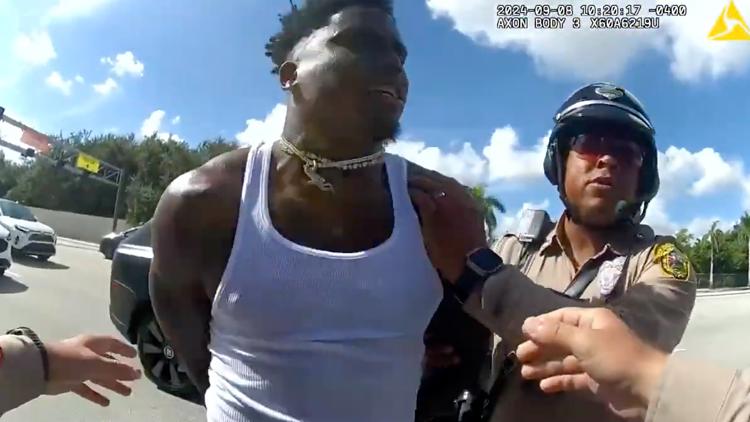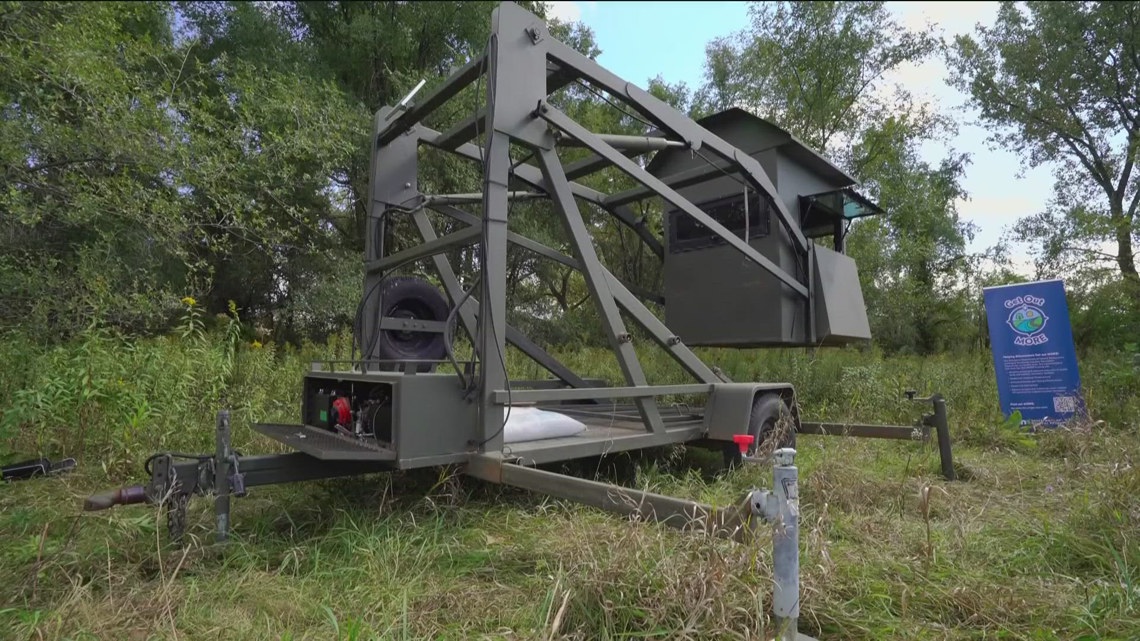Kare11
Tyreek Hill case raises questions of driver’s rights


Civil liberties experts say it’s best to cooperate and comply with law enforcement demands, but motorists have the right to remain silent and refuse a search.
MIAMI — American drivers might universally wince or brace themselves at the sight and sound of flashing red and blue lights and blaring sirens, but all drivers have constitutional rights when pulled over on the road.
The question of one’s responsibility to comply with all instructions given by a law enforcement officer recently came up following a pregame traffic stop this month involving Miami Dolphins wide receiver Tyreek Hill.
Although Hill has acknowledged he could have handled the interaction with Miami-Dade police better, the video of him being pulled out of his car, placed on the ground and handcuffed revived a national conversation about the realities of “driving while Black.” Studies show Black motorists are more likely to face the threat or use of force by police in traffic stops like Hill did, and many Black families give a version of “the talk” to loved ones about how to interact with police officers.
“The immediate short-term goal is to get out of the encounter without being arrested, and the way to do that, again, is to communicate not just with compliance, but obedience and respect, even if you don’t think that that’s deserved,” said Georgetown University law professor Paul Butler.
Studies show people of color are often disproportionately targeted for traffic stops in the U.S., said Jenn Rolnick Borchetta, the American Civil Liberties Union’s deputy director on policing.
“They search them more often, even as the rate at which they find evidence of some wrong is lower for Black and Latino people than white people,” she said.
In 2022, Black people accounted for nearly 13% of traffic stops in California, even though they were only 5% of the state’s population. Minneapolis, a predominantly white city, found in 2020 that Black drivers accounted for nearly 80% of police searches and routine traffic stops.
Miami lawyer E.J. Hubbs said he believes both Hill and the police officers in the now-viral video of the arrest had faults in their interactions.
Body camera footage showed the officer asking Hill to roll down his window and Hill complying, Hubbs said. Hill then told the officer “to give me my ticket,” after handing him his identification, which Hubbs said was also fair.
Where things escalated was when Hill decided to roll his window back up, as the officer’s body camera footage shows.
“When Mr. Hill refused to roll down his window, that was not complying with one of his commands,” Hubbs said. “And when he was asked to exit the car, he didn’t comply with that command, at least immediately.”
Lawrence Hunter, a former Waterbury, Connecticut, police captain and law enforcement coach, added that Hill appeared confrontational when asking Miami-Dade County officers not to knock on his window.
“From that point, because of the combative nature that Tyreek Hill exposed, the officer then asked him to get out of the car,” Hunter said. “That’s an officer safety thing. He already feels that this is uncooperative. … So therefore, it is best to just get him out of the car.”
Hunter added that Hill’s refusal to keep his window down could be considered a matter of officer safety.
During a traffic stop, drivers have constitutional rights against incriminating themselves or permitting the search of their car.
The right to remain silent is the most widely known right, Borchetta said. Drivers also have the Fourth Amendment right to be free from unreasonable searches and seizure, and have the right to ask traffic officers questions.
“You don’t have to tell the police where you’re coming from or where you’re going,” Borchetta said. “If they ask to search you or your car, you can say no. And if you’re not sure whether they’re asking or telling, you can ask them that question. And they have to tell you honestly.”
Passengers can also ask if they can leave the scene of the traffic stop.
Once a driver has been pulled over, police will likely run the plates of the vehicle through a database to check whether the car has been stolen or see if any other actionable information comes up, said Hunter, the former police captain.
The officer may also take a long, hard look at the vehicle for visible contraband, weapons or drugs, he said.
The officer does have the right to ask drivers and passengers to get out of the car and can use reasonable force to make sure that happens. Officers can also pull drivers over even if they haven’t committed an infraction, as long as there’s reasonable suspicion to think the person has, according to Butler, the Georgetown University professor. This policing practice is known as a pretextual stop.
Law enforcement can sometimes take advantage of civilians’ lack of knowledge of the law, Butler added. In that case, it’s best to comply and communicate with officers, and complain later.
Drivers can also record the conversation if they feel like the interaction with the officer has been unnecessarily escalated. But they should be sure to let the officer know that they are being recorded. Asking for and writing down the officer’s badge number, time and location of the interaction is also permitted.
Kare11
Minnesota DNR aims to make fishing, hunting more accessible


The Get Out MORE investments are helping ensure Minnesotans of all abilities are able to enjoy the outdoor activities the state has to offer.
ROSEMOUNT, Minn. — The Minnesota Department of Natural Resources (DNR) is working to make the outdoors more accessible, including improvements to hunting and fishing access.
“We make other states jealous would be putting it lightly. We hear a lot of feedback from our peers, our counterparts in other states, that wish they had the initiatives that we have here in Minnesota. We are extremely fortunate,” said Jamie Gangaware, Minnesota DNR wildlife operations manager and wildlife section.
The 2023 legislature approved a one-time $150 million for Get Out MORE (Modernize Outdoor Recreation Experiences) investments. About $5 million is committed to enhancing public access to wildlife management areas (WMA).
On Tuesday afternoon, Minnesota DNR staff and representatives from the organization Capable Partners gathered at Vermillion Highlands WMA in Rosemount.
The WMA has three different types of blinds that hunters with disabilities are able to use, including a hydraulic lift blind. It allows hunters to get a bird’s eye view.
The DNR is looking to add four more of these elevated blinds that can be moved all across the state to different WMAs.
“Try it because if you really love hunting, this will be your best opportunity to do such a thing,” said Barry Hite from Emily, Minn.
Hite has been hunting with Capable Partners for about 20 years.
The organization focuses on making the outdoors accessible.
“What a game-changer that has been. Without Capable Partners to help me, there’s no way I could hunt. Because that capable partner is my ears, my eyes, and they track,” said Terrie Schrank, president of Capable Partners.
Vermillion Highlands has partnered with the organization since 2011.
Tim Pharis, area wildlife supervisor for Dakota, Scott, Carver and a portion of Hennepin, recalled a blind hunter who came to the Vermillion Highlands with help from an assistant.
“To watch him come out of the blind and approach the deer… just watching him kind of feeling the antlers and touching parts of the deer’s body was a super emotional thing for me. It’s just a big take home message that we need to be providing more of these opportunities to the public,” Pharis said.
Other improvements will include seven fully accessible parking lots at WMAs and more than 100 projects to retrofit the DNR’s current hunting blinds and wildlife observation platforms to make them ADA compliant.
$5 million is being invested towards shore fishing access and improvements.
Jim Levitt, shore fishing coordinator for the section of fisheries with the MN DNR, said there are more than 300 potential sites across the state that could benefit from shore fishing improvements.
“If you’re a wheelchair user, it really limits you where you can go. And then when you really look at it and see how many of those are actually in the metro, if you’re outside the metro you’re really limited to the places that you can go fishing. So this program and the Get Out MORE funding has really allowed us to expand those opportunities all over the state,” Levitt said.
Levitt has a goal of completing 100 projects with the $5 million dollars they received.
In celebration of everything the state has to offer, Governor Tim Walz is proclaiming Saturday, Sept. 28 as Hunting and Fishing Day in Minnesota.
David Trauba, interim MN DNR wildlife section manager, read the proclamation at Tuesday’s press conference and presented the proclamation to Capable Partners.
Kare11
Man charged in deadly shooting at Brooklyn Park party


Lue Chang was charged with second-degree murder after prosecutors say he shot a man multiple times in the backyard where “numerous children were playing.”
BROOKLYN PARK, Minn. — A 32-year-old Brooklyn Park man allegedly shot and killed a man at a family celebration Saturday in Brooklyn Park, according to court documents.
Lue Chang was charged Tuesday with second-degree murder after prosecutors say he shot a man multiple times in a backyard where “numerous children were playing” during a celebration for the birth of multiple children in the family.
Witnesses told investigators that Chang shot the man multiple times before a group of family members jumped on him “to detain him and get the gun away from him,” according to the criminal complaint.
Officials say the shooting occurred just after 6:30 p.m. on the 8400 block of Adair Avenue North in Brooklyn Park. When officers arrived, they found a large group, including adults and children, scattered throughout the garage, backyard and inside the home. Investigators say the victim was laying on the ground, unconscious with multiple gunshot wounds to his abdomen and back. The man, later identified as 34-year-old Nichanon Kittikroekphon of Coon Rapids, was transported to North Memorial Hospital where he later died.
According to court documents, one of the witnesses who was holding down Chang asked him why he shot Kittikroekphon, and Chang responded “Because he disrespected me.” Another witness told police they heard Chang tell Kittikroekphon, “Today you’re going to die.” The witness said Chang then pulled out a handgun and shot Kittikroekphon.
Video of the shooting allegedly shows the two speaking before the shooting. Prosecutors say Chang looked “somewhat upset” in the video. At one point, Chang is allegedly seen pulling out a gun and shooting an unarmed Kittikroekphon. The video also showed a boy, believed to be about 2 years old, standing with a foot or so of the victim, according to the criminal complaint.
Kare11
Metro Transit Police Chief resigns during investigation into hostile workplace, sexual harassment claims, sources say


Sources inside the department tell KARE11 14 employees brought forward complaints of a hostile workplace or sexual harassment.
MINNEAPOLIS — Sources inside Metro Transit have confirmed to KARE11 that Ernest Morales III, the now-former police chief, has resigned amid an investigation into his conduct. Those sources say that comes after 14 employees brought forward sexual harassment or hostile workplace complaints.
This comes after Morales was placed on leave in August. His personnel file from the Metropolitan Council shows he was placed on non-medical leave, though it did not disclose what the reason was.
The Metropolitan Council declined to comment on Morales or this situation, but instead spoke on safety initiatives.
“At Metro Transit, providing a safe and welcoming system for our riders and employees is a top priority,” a statement from the council reads. “Strengthening public safety is an agency-wide effort involving everyone, and this important work continues without disruption.”
In August, Morales shared that ridership is up and overall reported crime is down.
As of this article’s publishing, Morales is still listed as chief on Metro Transit’s website. A billboard across the street from Metro Transit’s office near Target Field still bears a recruiting ad featuring Morales as of Tuesday afternoon.
Metro Transit officials say Captain Joseph Dotseth has agreed to serve as Interim Metro Transit Police Chief.


